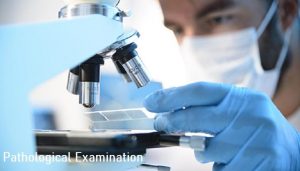
Pathological examination is a medical diagnostic technique that involves examining tissues, organs, or bodily fluids to identify and diagnose diseases or medical conditions. Pathology is the study of the structural and functional changes that occur in tissues and organs due to diseases or injuries.
Pathological examination may involve various techniques such as microscopy, histopathology, immunohistochemistry, molecular testing, and cytology. Microscopy involves using a microscope to examine tissue samples or bodily fluids. Histopathology involves examining tissue samples under a microscope to identify abnormal cellular changes or growths. Immunohistochemistry involves using antibodies to detect specific proteins in tissue samples, while molecular testing involves analyzing DNA, RNA, or other molecules to identify genetic mutations or abnormalities.
Cytology involves examining cells obtained from bodily fluids or tissue samples to identify abnormal changes. Pathological examination is often used to diagnose cancer, infectious diseases, autoimmune diseases, and other medical conditions.
Pathologists are medical doctors who specialize in the interpretation of pathological examinations. They work closely with other healthcare professionals to diagnose and manage diseases, provide treatment recommendations, and monitor patients’ progress. Pathological examination plays a critical role in the accurate diagnosis and effective treatment of many medical conditions.
Pathology diseases can be broadly categorized into three main groups based on their underlying causes: infectious diseases, genetic diseases, and acquired diseases.
- Infectious diseases: These are caused by infectious agents such as bacteria, viruses, fungi, parasites, and prions. Examples include tuberculosis, HIV/AIDS, influenza, malaria, and hepatitis.
- Genetic diseases: These are caused by genetic mutations or abnormalities that affect the normal functioning of cells or organs. Examples include cystic fibrosis, sickle cell anemia, hemophilia, and Huntington’s disease.
- Acquired diseases: These are caused by factors such as environmental exposures, lifestyle factors, and chronic medical conditions. Examples include cancer, heart disease, diabetes, and chronic obstructive pulmonary disease (COPD).
Within each of these categories, there are many different types of specific diseases. For example, within the category of infectious diseases, there are many different types of bacterial, viral, fungal, and parasitic infections. Similarly, within the category of acquired diseases, there are many different types of cancers and heart diseases. The specific type of pathology disease depends on the underlying cause, the affected organ or tissue, and other factors such as the individual’s age, gender, and overall health.
In medical terms, pathology refers to the study of the nature and causes of diseases. It involves examining tissues, organs, and bodily fluids to identify and diagnose diseases or medical conditions.
Pathology also involves the analysis of the underlying cellular and molecular changes that occur in response to disease, injury, or other factors. The study of pathology can help healthcare professionals understand the progression of diseases, predict how they will respond to treatment, and identify new treatment approaches.
Pathology is a broad field that includes various sub-specialties, including anatomical pathology, clinical pathology, molecular pathology, forensic pathology, and neuropathology, among others. Each of these sub-specialties focuses on a specific aspect of pathology, such as the examination of tissues or bodily fluids, the analysis of genetic and molecular changes, or the investigation of injuries and causes of death.
An example of pathology is the examination of a tissue sample to diagnose cancer. In this example, a healthcare provider may collect a small piece of tissue from a suspicious lump or growth, and a pathologist would examine the tissue under a microscope to identify any abnormal cellular changes that could indicate cancer.
The pathologist would look for specific features that are characteristic of cancer cells, such as abnormal cellular growth patterns, enlarged or irregularly shaped nuclei, or the presence of specific cellular markers. The pathologist would then make a diagnosis and provide information about the stage and severity of the cancer.
Other examples of pathology include the examination of bodily fluids, such as blood, urine, or cerebrospinal fluid, to diagnose infections or metabolic disorders; the analysis of genetic mutations to diagnose inherited diseases; and the investigation of causes of death in forensic pathology. Pathology plays a critical role in the accurate diagnosis and effective treatment of many medical conditions.
A pathological diagnosis is a medical diagnosis made by a pathologist, a medical doctor who specializes in diagnosing diseases based on the examination of tissues, organs, or bodily fluids. Pathological diagnosis is based on the examination of specimens collected during procedures such as biopsies, surgical resections, or autopsies.
The pathologist examines the specimens under a microscope, looking for abnormalities or changes in cells, tissues, or organs that could indicate a disease or medical condition. Based on these observations, the pathologist provides a diagnosis, which can be used by healthcare providers to develop a treatment plan.
Pathological diagnoses are often used to diagnose cancer, infectious diseases, autoimmune diseases, and genetic disorders. They are also used to monitor disease progression and response to treatment, and to investigate the causes of death in forensic pathology.
Pathological diagnosis is an essential part of modern medicine and plays a critical role in the accurate diagnosis and effective treatment of many medical conditions.

